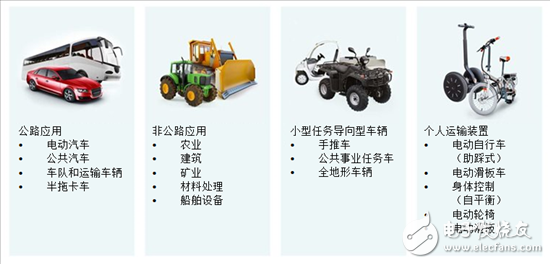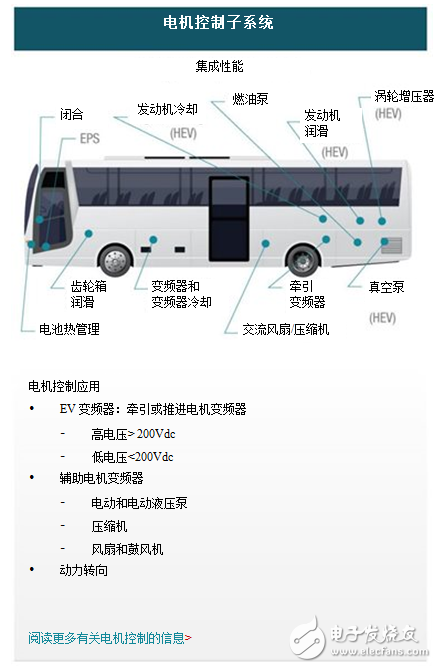When you hear an EV (electric car), you may immediately think of driving fast along the highway. But in fact, electric vehicles have a wide range of product categories. The EV is an arbitrary transport device whose propulsion system is driven by an electric motor (hybrid electric/internal combustion system will be referred to as hybrid electric), but the term definition can even be extended to the electrification of electric and non-electric propulsion systems (using electric motors to replace hydraulic or Belt drive system). This electrification often results in the need for other power conversion subsystems; Battery management, battery charging (onboard or off-board), regenerative/regenerative charging, DC-DC conversion, and DC-AC inversion.

For this discussion, we want to focus on the motor control subsystem. Similarly, the first thing you might think of is an excellent multi-kilowatt AC (asynchronous induction or permanent magnet synchronous) propulsion (traction) motor, which is the powerplant (and internal combustion engine replacement or supplement) for large cars, buses, and fleet vehicles. . These traction motors - even for smaller objects such as small electric vehicles - produce the torque needed to move the vehicle.
Most propulsion systems require very smooth control from zero speed and very low speed operation and are often inseparable from the overall operation of the product. Therefore, the rotor sensor is almost always used. In small personal transportation devices, these may be low cost magnetic Hall sensors, and in larger highway applications they may use solvers. The resolver is an analog absolute position sensor known for its overall ruggedness and compact form factor. The resolver sensor is energized by a sinusoidal carrier input and the absolute position of the rotor is encoded onto a pair of amplitude modulated sinusoidal outputs. These outputs can then be captured and decoded to produce a digital form of absolute rotor angle that can be used by the digital motor Controller. A common way to implement the resolver interface is to use a separate resolver to digital converter (such as TI's PGA411-Q1). Another approach is to integrate key excitation and analog-to-digital coding into the motor controller itself by using software and programmable peripherals, all through a simple external circuit interface. This is a unique feature offered by our DelfinoTM F2837x and microcontroller (MCU).
Although these propulsion motors perform well, when it comes to electric vehicles, they are also star products. Therefore, the focus of the rest of this blog is on other motors that must be controlled.
Most of these other motors are low voltage and low to medium current, making them ideal for TI motor control and drive technology.

An auxiliary motor is an auxiliary motor used to operate an auxiliary function that has historically driven a belt (energy from an internal combustion engine) or a hydraulic system. Air conditioning compressors, water/oil/cooling fluid pumps, fans, blowers, turbines, closures, and even various tools (agricultural equipment lifts, grips, forklifts, etc.) now need to be run from the motor. Most of these applications are very similar in nature to low voltage buses (most common 12, 24 or 48-V) and low to medium currents (<5A to 50A). The motor is used to control shifting or torque under changing load conditions. Although for some historical reasons, some still use Hall sensors for commutation, if the developer has the appropriate hardware and software expertise, almost all application usage (higher speed) can be done without sensors.
There are two related trends in this market that are worth noting. First, many of the traditional suppliers of these types of subsystems are belt-driven or hydraulic-type experts, or even motor experts, but not necessarily electronic motor control experts! The second reason is that many electric vehicle customers who have purchased motor and motor controllers for these auxiliary systems – especially if their focus is on propulsion systems – are investigating whether it is feasible to install these auxiliary control subsystems inside the vehicle. And economically profitable. This will lead to market shifts: EV customers evaluate whether they can design themselves; existing suppliers look for the latest control technology to maintain their motor and control business; and motor control suppliers from neighboring industries (electrical and industrial) want to pass Become a new supplier or provide design expertise to expand your customer base. All three wishes are the same: a quick assessment, and then the development of a low-voltage, high-performance, high-efficiency, sensorless motor control system for a variety of possible changes in motors for a variety of EV applications.
In the next article, we will discuss the control of other motors in more detail.
To learn more about EV and motor control, please visit the following link:
Learn more about EV equipment
Start developing your next motor with the Delfino F2837x MCU
Start developing the next motor with the Piccolo F2807x MCU
Download the motor control white paper for EV equipment
DC Cooling Products includes DC Solar fridge,DC Solar Freezer,DC Solar Conditioner,DC Solar Fan and other solar energy electric items.
Dc Powered Refrigerator,Dc Mini Fridge,Full Dc Inverter Aircon,Dc Ceiling Fan With Light
NANTONG RONGCHANG IMPORT&EXPORT CO.,LTD , https://www.ergsolarcn.com